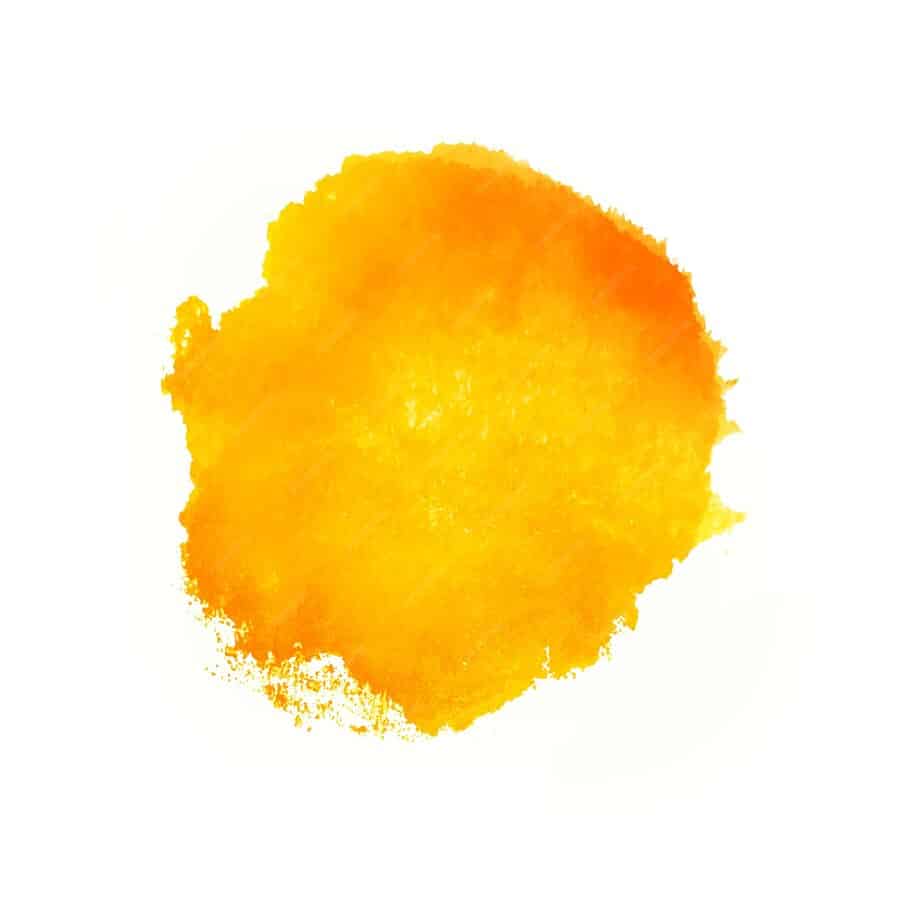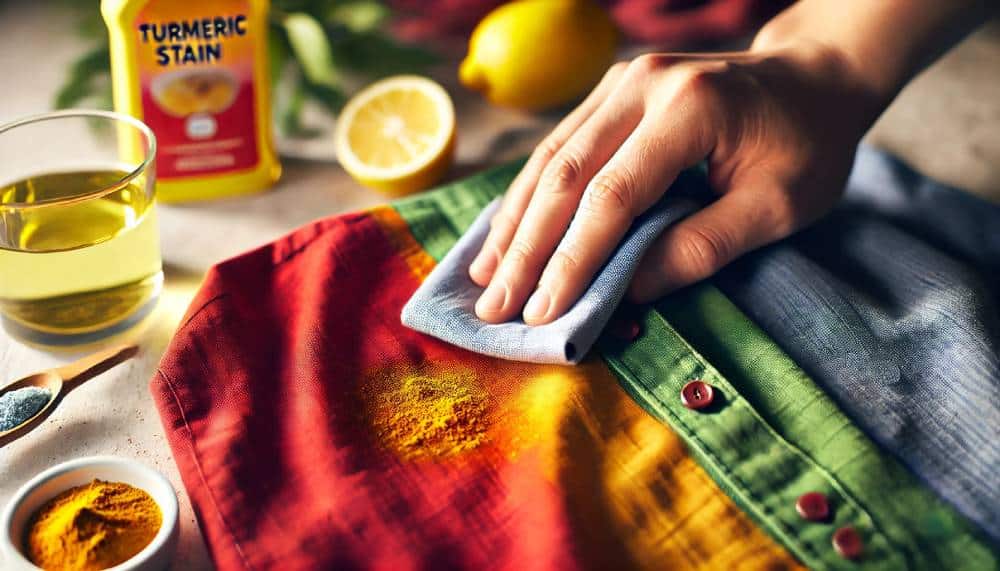Turmeric stains are notorious for their bright yellow color and the challenge they pose when it comes to removing them. Whether you’ve spilled turmeric while cooking, enjoying a turmeric latte, or during a DIY beauty routine, these stains can seem impossible to get rid of. However, with the right techniques and tools, removing turmeric stains from your clothes doesn’t have to be a daunting task.
In this post, we’ll guide you on how to remove turmeric stains from clothes, focusing on both white and colored fabrics, as well as delicate materials. Follow these easy steps to tackle turmeric stains with confidence and restore your clothes to their former glory!
How to Remove Turmeric Stains from White Clothes

White clothes are particularly susceptible to visible stains, and turmeric is no exception. When dealing with turmeric stains on white clothing, the goal is to act quickly and use the right stain-fighting methods. Here’s what you can do:
- Rinse Immediately: As soon as the stain occurs, rinse the affected area with cold water. This helps remove as much turmeric as possible before it sets into the fabric. If the stain is fresh, rinsing it under cold running water is one of the best ways to keep it from becoming permanent.
- Apply Dish Soap or Laundry Detergent: Gently rub some dish soap or liquid laundry detergent into the stained area. Let it sit for about 10–15 minutes. Dish soap is effective at breaking down the oils in turmeric, helping to lift the stain. You can also use a laundry stain remover if you have one available for extra stain-fighting power.
- Use a Baking Soda Paste: If the stain persists, make a paste by mixing baking soda with water. Apply the paste to the stained area and gently scrub with a soft brush. Leave it for another 10 minutes, then rinse with cold water. Baking soda is a natural abrasive and acts as a mild bleach alternative, perfect for tackling stubborn stains.
- Wash and Dry: Once the stain is gone, wash your white clothes in the washing machine as usual. Be sure to check the stained area before drying. Avoid putting the clothes in the dryer until you’re sure the stain is completely gone, as heat can set the stain and make it more difficult to remove.
By following these steps, you can easily remove turmeric stains from white clothes and restore their brightness.
How to Remove Turmeric Stains from Colored Clothes

Colored clothes present a unique challenge because the stain may affect the fabric’s dye. When removing turmeric stains from colored fabrics, it’s essential to use gentler methods to avoid fading or damaging the fabric. Here are the steps you should follow:
- Cold Water Rinse: Just like with white clothes, rinse the stained area immediately with cold water to prevent the turmeric from setting. Don’t rub the stain—just gently blot it with a clean cloth.
- Apply Mild Detergent: Use a mild detergent to pre-treat the stain. Gently rub the detergent into the stain and let it sit for 10 minutes. This will help lift the turmeric without affecting the fabric’s color. Be sure to test the detergent on an inconspicuous area first to ensure it won’t cause fading.
- Try Vinegar or Lemon Juice: For extra stain-fighting power, apply white vinegar or lemon juice to the stained area. Both are natural stain removers and can help break down the turmeric without harming your clothes. Let the solution sit for 5–10 minutes before rinsing it off.
- Wash and Air Dry: Wash the fabric on a gentle cycle with cold water. Avoid using hot water, as it can set the stain. Afterward, air-dry the clothes rather than using a dryer. The heat from the dryer could cause the turmeric stain to set permanently.
By following these steps, you can safely remove turmeric stains from your colored clothes without worrying about fading or discoloration.
What to Do for Delicate Fabrics
Some fabrics, such as silk, wool, and satin, require extra care to prevent damage. If you’ve spilled turmeric on a delicate fabric, it’s important to use gentle, natural methods to avoid harming the material. Here’s how to tackle turmeric stains on delicate fabrics:
- Blot with a Cloth: Avoid rubbing the stain; instead, gently blot the stained area with a clean cloth. This will absorb excess turmeric without spreading it further. Always use a cloth that won’t cause friction or damage the fabric.
- Use Mild Soap and Water: Mix mild soap with lukewarm water. Soak a soft cloth or sponge in the solution and dab at the stain. Be careful not to soak the fabric completely. Too much water can damage delicate materials. This method works best for fabrics like silk and wool.
- Use Professional Dry Cleaning: If the stain persists or if you’re unsure of how to handle the fabric, it’s best to seek professional dry cleaning services. Delicate fabrics like silk can be tricky to treat at home, and a professional cleaner will know the best approach to remove the stain safely and effectively.
For delicate fabrics, always prioritize gentler methods to avoid permanent damage.
How to Clean Old Turmeric Stains
Turmeric stains can be difficult to remove once they’ve set in, but don’t worry—it’s still possible to clean them. If you’re dealing with an old turmeric stain, try the following techniques:
- Apply a Stain Remover: If the stain has dried, apply a commercial stain remover to the affected area. Let it sit for 15–30 minutes, depending on the product’s instructions. Make sure to follow the manufacturer’s guidelines to avoid damage to the fabric.
- Use a Paste of Baking Soda and Water: For stubborn, set-in stains, mix baking soda with a small amount of water to form a paste. Apply the paste to the stain and let it sit for 30 minutes before rinsing it off with cold water. This method works wonders for older stains that need extra scrubbing power.
- Try Hydrogen Peroxide: For white clothes or fabrics that won’t be damaged by bleaching, hydrogen peroxide can help remove old turmeric stains. Apply it directly to the stain, wait 10 minutes, then rinse with cold water. Be careful when using this method on colored fabrics, as it may cause bleaching.
- Repeat if Necessary: If the stain is still visible after the first round of treatment, repeat the process until it’s completely gone. Sometimes, old turmeric stains may require multiple treatments to fully lift.
Old turmeric stains may take a bit more effort, but with patience and the right technique, they can be removed!
Natural Solutions for Turmeric Stains
If you prefer to use natural methods to remove turmeric stains, you’re in luck! Many household products can help you get rid of turmeric stains effectively without resorting to harsh chemicals. Here are some natural solutions you can try:
- Lemon Juice: The acidity in lemon juice helps break down the turmeric. Apply lemon juice directly to the stain, let it sit for 5–10 minutes, then rinse with cold water. The citric acid in lemon juice helps dissolve the stain naturally.
- Vinegar: White vinegar is another natural solution that works wonders on turmeric stains. Mix one part vinegar with two parts water, apply to the stain, and let it sit for 10 minutes before rinsing. Vinegar is an effective alternative to commercial stain removers.
- Baking Soda: Baking soda’s abrasive texture helps scrub away turmeric stains. Make a paste with baking soda and water, apply to the stain, scrub gently, then rinse. Baking soda can be especially useful when dealing with stubborn turmeric stains.
These natural solutions are safe and effective for removing turmeric stains from your clothes without resorting to harsh chemicals or bleach.
Conclusion
Turmeric stains don’t have to be a nightmare when it comes to cleaning your clothes. Whether you’re dealing with white, colored, or delicate fabrics, there are effective methods to remove turmeric stains and keep your clothes looking as good as new. By acting quickly, using the right products, and following the steps above, you can safely remove turmeric stains from your clothes.
If you’re looking for professional help with stubborn stains or need dry cleaning services, feel free to check out Kanojia Dry Cleaners’ Services. For more stain removal tips and tricks, visit our blog.



